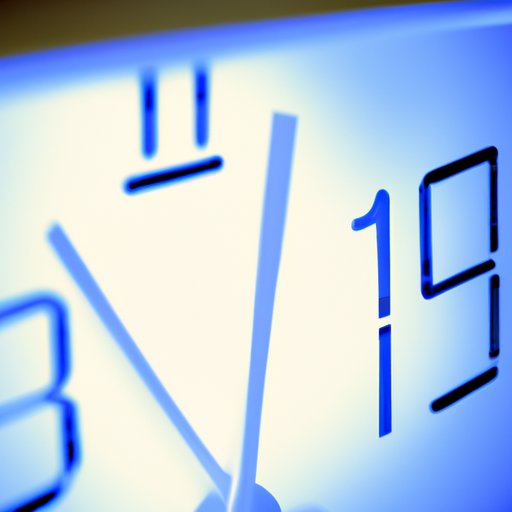
Introduction
Telling time is an essential skill that helps us keep track of our daily activities. Whether it’s attending a meeting, catching a flight or simply knowing when to eat our meals, we rely on clocks to provide us with the information we need to manage our time. Clocks come in different types, each with its unique features and approaches to tell time. This article will provide a comprehensive guide on how to tell time, covering analog and digital clocks, telling time in different languages, reading unusual clocks and tips for teaching kids how to tell time.
A Step-by-Step Guide
An analog clock has three main components that work together to tell time: the hour hand, the minute hand and the second hand. The hour hand is typically the shortest and indicates the hour. The minute hand is longer and shows the minutes passed, and the second hand provides the seconds passed.
To tell time on an analog clock, follow these steps:
- Locate the hour hand and determine the hour it points to. It has a distinct shape, often shorter and thicker than the minute hand
- Identify the minute hand by its length, which usually points to the minutes. The tip of the minute hand shows the current minute
- If there is a second hand, it tells you the seconds passed. You can ignore it if you want to know the minute or hour only
It is also essential to know that the clock face has 12 hours, with each hour marked by a number. Hence, a clock face has a sequence of 12 numbers, each representing an hour.
Comparing Analog and Digital Clocks
Another common type of clock is the digital clock, which displays the time in numeric form. Unlike analog clocks, which can have a 12 or 24-hour format, digital clocks are typically in the 24-hour format, meaning it counts from 0-24 instead of 1-12.
To tell time on a digital clock, follow these steps:
- Identify the hour digits on the LCD or LED display. It provides a two-digit number, with the first digit representing the tens place and the second the ones place
- The minutes are usually displayed after a colon next to the hour number.
- Like analog clocks, digital clocks might have a ‘PM’ displayed to indicate afternoon or evening time and ‘AM’ for morning time
It is also essential to note that some clocks do not distinguish between AM and PM with the ’24 hour’ format discussed earlier. As such, 15:00 in a digital clock means 3:00 PM on a 12 hour format clock.
Telling Time in Different Languages
Many languages have different ways of telling time, reflecting the country’s culture and history. For example, Spanish speakers tend to use “y media” to refer to half an hour past the hour instead of thirty minutes past. Arabic speakers often refer to hours using the phrase “after midday” or “before midday” rather than using an actual number.
Here’s how to tell time in different languages:
- German: To tell time in German, use the phrase “Es ist” (meaning “it is”), followed by the hour and minutes. For example, “Es ist fünf Minuten nach drei” means it is five past three.
- French: To tell time in French, use the phrase “il est” (meaning “it is”), followed by the hour and minutes. For example, “il est deux heures et quart” means it is two fifteen.
- Italian: To tell time in Italian, use the phrase “Sono le” (meaning “It is”), followed by the hour and minutes. For example, “Sono le nove e venti” means it is twenty past nine.
- Chinese: To tell time in Chinese, state the hour first, then the minutes. For example, “Shíwǔ fēnzhōng” means it’s 15 past.
Telling Time with Unusual Clocks
Clocks can come in unusual forms such as sundials, water clocks, sand clocks and more. Unlike conventional clocks, these clocks use unconventional ways to tell time.
Here’s how to read time on some unusual clocks:
- Sundials: Sundials use the sun’s shadow to tell time. The dial is marked with hours, and as the sun moves across the sky, the shadow falls on the corresponding hour
- Water clocks: Water clocks use water flow to tell time. As water flows from one container to another, the level of water marks the corresponding hour
- Sand clocks: Sand clocks use the flow rate of sand to tell time. The time passed is determined by the amount of sand that has flown to the other side of the device.
Tips for Teaching Kids How to Tell Time
Teaching children how to tell time on a clock can be frustrating and challenging. However, with the right tools and techniques, it can be easy and fun. Here are some guidelines for teaching kids how to tell time:
- Show them the clock and its different components
- Use games and activities to make learning fun
- Create a clock out of cardboard, a paper plate or playdough to show them demonstrations of how to tell time
- Ask them to practice telling time using a special watch or clock of their own
Conclusion
Telling time is an integral skillset that enables us to manage our time effectively. This guide provides step-by-step instructions on telling time on different types of clocks, including analog and digital clocks, telling time in different languages and reading unusual clocks. For parents and teachers, there are tips for teaching kids how to tell time easily. With this guide, you’ll be able to read the time on any clock easily.





